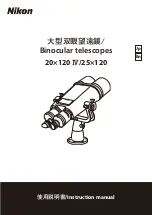
5
for objects randomly, without knowing where to look. It is
best to have specific targets in mind before you begin look-
ing through the eyepiece.
A. The Moon
The Moon, with its rocky, cratered surface, is one of the
easiest and most interesting subjects to observe with your
telescope. The myriad craters, rilles, and jagged moun-
tain formations offer endless fascination. The best time to
observe the Moon is during a partial phase, that is, when
the Moon is not full. During partial phases, shadows cast by
crater walls and mountain peaks along the border between
the dark and light portions of the lunar disk highlight the
surface relief. A full Moon is too bright and devoid of surface
shadows to yield a pleasing view. Try using a Moon filter to
dim the Moon when it is too bright; it simply threads onto the
bottom of the eyepiece.
B. The Sun
You can change your nighttime telescope into a daytime Sun
viewer by installing an optional full-aperture solar filter over
the front opening of the ShortTube 80. The primary attraction
is sunspots, which change shape, appearance, and location
daily. Sunspots are directly related to magnetic activity in the
Sun. Many observers like to make drawings of sunspots to
monitor how the Sun is changing from day to day.
Important Note: Do not look at the Sun with any optical
instrument without a professionally made solar filter, or per-
manent eye damage could result.
C. The Planets
The planets don’t stay put like stars do (planets don’t have
fixed R.A. and Dec. coordinates), so you will have to refer
to Sky Calendar at our website, www.telescope.com, or to
charts published monthly in
Astronomy
,
Sky & Telescope
,
or other astronomy references to locate them. Venus, Mars,
Jupiter, and Saturn are the brightest objects in the sky after
the Sun and the Moon. All four of these planets are not nor-
mally visible in the sky at one time, but chances are one or
two of them will be.
D. Stars
Stars will appear like twinkling points of light in the tele-
scope. Even the largest telescopes cannot magnify stars
to appear as anything more than points of light! You can,
however, enjoy the different colors of the stars and locate
many pretty double and multiple stars. The famous “Double-
Double” in the constellation Lyra and the gorgeous two-color
double star Albireo in Cygnus are favorites. Defocusing the
image of a star slightly can help bring out its color.
E. Deep-Sky Objects
Under dark skies, you can observe a number of brighter
deep-sky objects with your ShortTube 80, including gas-
eous nebulas, open and globular star clusters, and the
brighter galaxies. Most deep-sky objects are very faint, so it
is important that you find an observing site well away from
light pollution. Take plenty of time to let your eyes adjust
to the darkness. Don’t expect these objects to appear like
the photographs you see in books and magazines; most
will look like dim gray “ghosts.” (Our eyes are not sensitive
enough to see color in deep-sky objects except in few of the
brightest ones.) But as you become more experienced and
your observing skills improve, you will be able to coax out
more and more intricate details.
Calculating Magnification
(Power)
It is desirable to have a range of eyepieces of different focal
lengths, to allow viewing over a range of magnifications. To
calculate the magnification, or power, of a telescope, simply
divide the focal length of the telescope by the focal length of
the eyepiece:
Magnification = Telescope F.L. ÷ Eyepiece F.L.
For example, the ShortTube 80, which has a focal length of
400mm, used in combination with the supplied 25mm Sirius
Plössl eyepiece, yields a power of
400 ÷ 25 = 16x.
Every telescope has a useful limit of power of about 45x-60x
per inch of aperture, which is 140x-180x for the ShortTube
80. Claims of higher power by some telescope manufactur-
ers are a misleading advertising gimmick and should be
dismissed. Keep in mind that at higher powers, an image will
always be dimmer and less sharp (this is a fundamental law
of optics). The steadiness of the air (the “seeing”) can also
limit how much magnification an image can tolerate.
Always start viewing with your lowest-power (longest focal
length) eyepiece in the telescope. After you have located
and looked at the object with it, you can try switching to a
higher-power eyepiece, like the supplied 10mm Sirius Plössl
eyepiece, to ferret out more detail. If the image you see is not
crisp and steady, reduce the magnification by switching to a
longer-focal-length eyepiece. As a general rule, a small but
well-resolved image will show more detail and provide a more
enjoyable view than a dim and fuzzy, overmagnified image.
Photography with the ShortTube 80
With an optional camera adapter, the ShortTube 80
becomes a 400mm f/5 telephoto lens for a single-lens reflex
camera. For long-distance terrestrial or astronomical pho-
tography, you need only a T-ring for your particular camera
model. The T-ring attaches to your particular camera model
Figure 3.
The ShortTube 80 with 35mm SLR camera attached.
Summary of Contents for ShortTube 80 9386
Page 7: ...7 ...
















